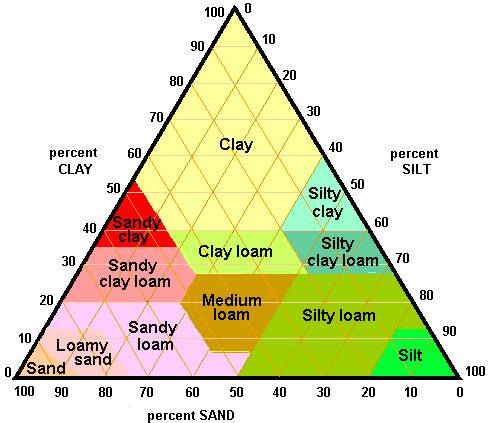Competency Area 2: Basic Concepts of Soil Fertility
PO 12. Describe how the following soil characteristics affect nutrient uptake.
- Texture
- Structure
- Drainage and aeration
- Moisture
- pH
- Temperature
Texture is defined as the proportion of sand, silt, and clay in the soil. High clay content increases CEC and thus the ability to hold nutrients, while high sand content decreases the CEC and nutrient holding capacity. Sandy soils also have large pore spaces, allowing more leaching of nutrients. See the next page for a diagram of various soil texture characteristics. A diagram provided in the next few pages demonstrates the different components of soil texture.
Structure is defined as the arrangement of soil particles into aggregates. Good structure is essential for water and nutrient movement, penetration, and retention. Large spaces between aggregates allows soil water (and the nutrients dissolved therein) to move more freely, resulting in leaching losses. Small or no spaces between aggregates, especially due to compaction, prevents water from moving through the soil profile, resulting in runoff.
Drainage and aeration have effects on nutrient loss and solubility. Poorly-drained soils are poorly aerated, as they flood easily. This promotes nitrogen loss through denitrification, while excessively-drained (sandy) soils promote leaching losses. Flooded or very wet soils increase the solubility of minerals like iron and manganese.
Moisture is important for root growth and nutrient uptake. Adequate moisture will improve uptake of nutrients by diffusion and root interaction, and will increase organic matter decomposition, which releases N, P, and S. Low moisture can result in the formation of insoluble nutrient-containing compounds.
pH affects nutrient availability by changing the nutrient form. For instance, the different forms of N (affected by pH) have different leaching capabilities; other nutrients may become adsorbed or desorbed, precipitated, mineralized, or immobilized at different pH values. Many nutrients are more available in slightly acid soils: P is most available at a neutral pH (about 6.5); Mb is available at high pH and can be toxic to plants. The pH is also important in N transformations, such as mineralization, nitrification, and N fixation, as the bacteria involved are pH-sensitive.
Temperature affects the plant's ability to grow, and thus affects nutrient uptake. Ideal temperatures vary by plant species and cultivar. The soil temperature also influences microbial activity, an important part of organic material decomposition.

Quick Links
- Competency Area 1: Basic Concepts of Plant Nutrition
- Competency Area 2: Basic Concepts of Soil Fertility
- Competency Area 3: Soil Testing and Plant Tissue Analysis
- Competency Area 4: Nutrient Sources, Analyses, Application Methods
- Competency Area 5: Soil pH and Liming
- Competency Area 6: Nutrient Management and Planning
